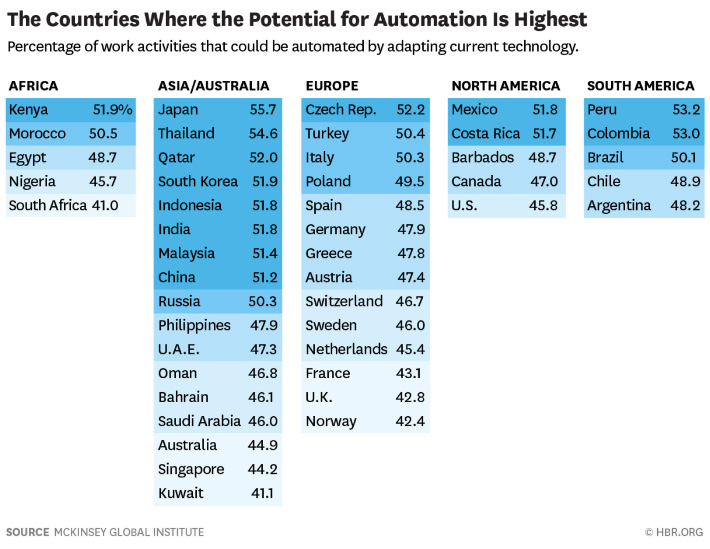When widespread automation hits, it will be a global force, impacting advanced and emerging economies alike in profound, and unique ways.
That should come as no surprise. The trend of outsourcing jobs in such industries as manufacturing and IT – jobs that are highly vulnerable to obsolescence in the face of new technology – will result in even poorer countries transitioning to automated workforces in order to stay competitive.
What may come as a surprise, however, is that the percentage of jobs that could be potentially automated using technology currently available is quite similar across many of the world’s leading economies, regardless of the size or stability of each individual economy.
In a new report from the McKinsey Global Institute entitled A Future That Works: Automation, Employment, and Productivity, 46 countries responsible for 80% of the global workforce were examined to analyse not just the state of their industries, as is often the case with such studies, but how susceptible individual elements of workplace activity were to automation. The results are as follows:

In total, 1.2 billion full-time equivalent jobs, and $14.6 trillion in wages are associated with these work activities, which are tied up in anywhere between 55.7% and 41% of jobs in the relevant nations.
The findings are based on jobs within sectors rather than the sectors themselves, reflecting a more specific impact than we’ve seen in the past. For instance, when looking at the manufacturing industry, researchers took into consideration the ratio and distribution of production, administration, and management jobs, and how multinational companies or those that outsource are impacted accordingly.
McKinsey’s research raises the importance of putting schemes into place that will protect those who will find themselves out of work. Keep in mind that these figures are based on current technology, not the technology expected to come into fruition over the next 10 – 15 years.
This is especially relevant in the four leading economies: Japan, India, China, and the U.S. They make up over half these wages, and almost two-thirds of the jobs under threat. The first three are expected to see over half their working population affected, and none currently have policies utilised to deal with such a shift.
The report stresses that this is not cause for concern. It predicts that productivity growth from automation could reach as high as 1.4% by 2065 – over twice that produced by the IT boom of the 90s – but is measured with the expectation that humans will still form a function in the workforce:
“It is of a similar order of magnitude to the long-term technology-enabled shifts away from agriculture in developed countries’ workforces in the 20th century. Those shifts did not result in long-term mass unemployment, because they were accompanied by the creation of new types of work. We cannot definitively say whether things will be different this time. But our analysis shows that humans will still be needed in the workforce: the total productivity gains we estimate will only come about if people work alongside machines. That in turn will fundamentally alter the workplace, requiring a new degree of cooperation between workers and technology.”
Yet these jobs are no better defined than they have ever been, and we are not talking about one industry, but potentially every industry. It is not enough to simply say that the jobs will come; we have to make the effort to seek them out, and prepare accordingly.
